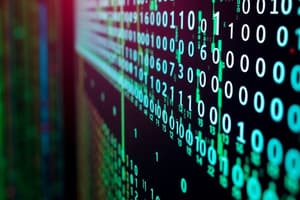Podcast
Questions and Answers
What is the term used to describe the number of bits a CPU can work with in a single operation?
What is the term used to describe the number of bits a CPU can work with in a single operation?
Word size
Which of the following is NOT a common number system used in computing?
Which of the following is NOT a common number system used in computing?
- Binary
- Octal
- Quinary (correct)
- Decimal
Hexadecimal numbers are used in web page development to define colors.
Hexadecimal numbers are used in web page development to define colors.
True (A)
What is the primary reason for using hexadecimal numbers in microprocessors?
What is the primary reason for using hexadecimal numbers in microprocessors?
What is the base of the binary number system?
What is the base of the binary number system?
How many different colors can be represented by 216 bits?
How many different colors can be represented by 216 bits?
Match the following number system conversions with their correct process:
Match the following number system conversions with their correct process:
What is the octal equivalent of the binary number 10011100?
What is the octal equivalent of the binary number 10011100?
What is the hexadecimal equivalent of the binary number 10011100?
What is the hexadecimal equivalent of the binary number 10011100?
Flashcards
Bit
Bit
The smallest unit of information in computing, represented as 0 or 1.
Binary System
Binary System
A number system using only two digits (0 and 1).
Word Size
Word Size
The number of bits a CPU can process at once.
Data Representation
Data Representation
Signup and view all the flashcards
Decimal System
Decimal System
Signup and view all the flashcards
Hexadecimal System
Hexadecimal System
Signup and view all the flashcards
Octal System
Octal System
Signup and view all the flashcards
Memory Address
Memory Address
Signup and view all the flashcards
Word
Word
Signup and view all the flashcards
Binary encoding
Binary encoding
Signup and view all the flashcards
Study Notes
Introduction to Computing - Week 2: Data Representation
- Data Representation: Modern computers use binary (base 2) representation, unlike early digital computers which used decimal (base 10).
- Bit: A bit is the fundamental unit of information in computing. It can have one of two values: 0 or 1.
- Binary Digits: A binary digit (bit) can also be represented as logical values (true or false; on or off).
- Punched Cards: Early computers used punched cards to represent data, each position on the card carrying one bit of information.
- Word Size: The number of bits a CPU can process in one operation is known as the word size. This is important for processor design and architecture.
- Memory Addressing: The CPU's ability to directly address memory locations depends on its word size. A 32-bit CPU, for example, can directly address 232 memory locations.
- Memory Organization: Memory consists of millions of storage cells, each storing one bit of information. Memory can be viewed as a collection of words. Each n-bit group is a word, where 'n' describes the word length.
Number Systems
- Number System Bases: Commonly used number systems include decimal (base 10), binary (base 2), octal (base 8), and hexadecimal (base 16).
- Radix: The base of a number system is also called the radix. The radix determines the number of unique digits used in the system. The decimal system has 10 digits, while the binary system uses 2, and so on
- Hexadecimal: Hexadecimal uses 16 digits (0-9 and A-F). It's more concise than binary for representing data in computer systems (e.g., for colors, memory addresses, and error codes).
- Octal: Octal uses 8 digits (0-7). It was commonly used in the past for expressing binary values in a shorter form.
Conversion Between Number Systems
- Decimal to Binary: Divide the decimal number by 2 repeatedly, noting the remainders until the quotient is 0. Write the remainders in reverse order to get the binary representation.
- Binary to Decimal: Multiply each binary digit by the corresponding power of 2 (starting with 20), and sum the results to get the decimal equivalent.
- Decimal to Octal: Divide the decimal number by 8 repeatedly, noting the remainders until the quotient is 0. Write the remainders in reverse order to get the octal representation.
- Octal to Decimal: Multiply each octal digit by the corresponding power of 8 (starting with 80), and sum the results to get the decimal equivalent.
- Decimal to Hexadecimal: Divide the decimal number by 16 repeatedly, noting the remainders until the quotient is 0. Convert the remainders to their hexadecimal equivalent (0-9 and A-F) to get the hexadecimal representation.
- Hexadecimal to Decimal: Multiply each hexadecimal digit by the corresponding power of 16 (starting with 160), sum the results to get the decimal equivalent.
Applications of Different Number Systems
- Data Representation: Computers use binary to represent data. Other number systems offer shorthand representations used in various applications (e.g., colors, hardware locations).
- Computer Architecture: Computers use binary for all internal data representation and logic operations.
- Memory Locations: Hexadecimal is used to represent memory addresses and to describe memory locations.
- Colors: Hexadecimal is used to represent colors (each primary RGB color being described by two hexadecimal digits).
Studying That Suits You
Use AI to generate personalized quizzes and flashcards to suit your learning preferences.




